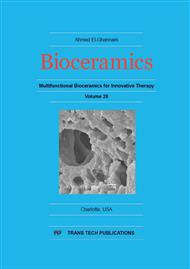[1]
Engin NO, Tas AC. Manufacture of Macroporous Calcium Hydroxyapatite Bioceramics. J Eur Ceram Soc 1999; 19: 2569-2572.
DOI: 10.1016/s0955-2219(99)00131-4
Google Scholar
[2]
Kwon SH, Jun YK, Hong SH, Kim HE. Synthesis and Dissolution Behavior of β-TCP and HA/β-TCP Composite Powders. J Eur Ceram Soc 2003; 23: 1039–1045.
DOI: 10.1016/s0955-2219(02)00263-7
Google Scholar
[3]
Hannora AE. Preparation and Characterization of Hydroxyapatite/Alumina Nanocomposites by High-Energy Vibratory Ball Milling. J. Ceram. Sci. Tech. 2014; 5: 293-298.
Google Scholar
[4]
Descampsa M, Boilet L, Moreaua G, Tricoteaux A, Lud J, Leriche A, Lardot V, Cambier F. Processing and Properties of Biphasic Calcium Phosphates Bioceramics Obtained by Pressureless Sintering and Hot Isostatic Pressing. Journal of the European Ceramic Society 2013; 33: 1263-1270.
DOI: 10.1016/j.jeurceramsoc.2012.12.020
Google Scholar
[5]
Brown O, McAfee M, Clarke S, Buchanan F. Sintering of Biphasic Calcium Phosphates. J Mater Sci Mater Med 2010; 21: 2271-2279.
DOI: 10.1007/s10856-010-4032-6
Google Scholar
[6]
Goller G, Demirkiran H, Oktar FN, Demirkesen. Processing and Characterization of Bioglass Reinforced Hydroxyapatite Composites. Ceram. Int. 2003; 29: 721- 724.
DOI: 10.1016/s0272-8842(02)00223-7
Google Scholar
[7]
Demirkol N, Oktar FN, Kayali ES. Influence of Niobium Oxide on the Mechanical Properties of Hydroxyapatite. Key Engineering Materials 2013; 529-530: 29- 33.
DOI: 10.4028/www.scientific.net/kem.529-530.29
Google Scholar
[8]
Rao RR, Kannan TS. Synthesis and Sintering of Hydroxyapatite-Zirconia Composites. Mater Sci. Engineer 2002; 20: 187-193.
Google Scholar
[9]
Mobasherpour I, Hashjin MS, Toosi SSR, Kamachali RD. Effect of the Addition ZrO2-Al2O3 on Nanocrystalline Hydroxyapatite Bending Strength and Fracture Toughness. Ceram. Int. 2009; 35: 1569-1574.
DOI: 10.1016/j.ceramint.2008.08.017
Google Scholar
[10]
Ayed FB, Bouaziz J. Sintering of Tricalcium Phosphate–Fluorapatite Composites by Addition of Alumina. Ceramics International 2008; 34: 1885–1892.
DOI: 10.1016/j.ceramint.2007.07.017
Google Scholar
[11]
Samodurovaa A, Kocjana A, Swainb MV, Kosmaca T. The combined effect of alumina and silica co-doping on the ageing resistance of 3Y-TZP bioceramics. Acta Biomaterialia 2015; 11: 477-487.
DOI: 10.1016/j.actbio.2014.09.009
Google Scholar
[12]
Hisbergues M, Vendeville S, Vendeville P. Zirconia: Established Facts and Perspective for a Biomaterial in Dental. J Biomed. Mater. Res. B: Appl. Biomater 2009; 88: 519-529. Daou EE. The Zirconia Ceramic: Strengths and Weaknesses. Open Dent J. 2014; 8: 33-42.
DOI: 10.1002/jbm.b.31147
Google Scholar
[13]
Evis Z. Reactions in Hydroxylapatite-Zirconia Composites. Ceramics International 2007; 33: 987-991.
DOI: 10.1016/j.ceramint.2006.02.012
Google Scholar
[14]
Faure J, Drevet R, Lemelle A, Ben Jaber N, Tara A, El Btaouri H, Benhayoune H. A New Sol–Gel Synthesis of 45S5 Bioactive Glass Using an Organic Acid as Catalyst. Materials Science and Engineering 2015; 47: 407–412.
DOI: 10.1016/j.msec.2014.11.045
Google Scholar
[15]
Verne E, Ferraris S, Cassinelli C, Boccaccini AR. Surface Functionalization of Bioglass with Alkaline Phosphatase. Surface and Coatings Technology 2015; 264: 132-139.
DOI: 10.1016/j.surfcoat.2015.01.001
Google Scholar
[16]
Yelten A, Yilmaz S, Oktar FN. Comparison of Microstructures of Bovine Hydroxyapatite and Sol-Gel Derived Porous Alumina-Hydroxyapatite Biocomposite Powders. Key Engineering Materials 2012; 493-494: 551-555.
DOI: 10.4028/www.scientific.net/kem.493-494.551
Google Scholar
[17]
Pujiyanto E, Tontowi AE, Wildan MW, Siswomihardjo W. Porous Hydroxyapatite–Zirconia Composites Prepared by Powder Deposition and Pressureless Sintering. Advanced Materials Research 2012; 445: 463-468.
DOI: 10.4028/scientific5/amr.445.463
Google Scholar
[18]
Salman S, Oktar FN, Gunduz O, Agathopoulos S, Ovecoglu ML, Kayali ES. Sintering Effect on Mechanical Properties of Composites Made of Bovine Hydroxyapatite (BHA) and Commercial Inert Glass (CIG). Key Engineering Materials 2007; 330-332: 189-192.
DOI: 10.4028/www.scientific.net/kem.330-332.189
Google Scholar
[19]
Kokubo T, Takadama H. How Useful is SBF in Predicting In Vivo Bone Bioactivity?. Biomaterials 2006; 27: 2907-2915.
DOI: 10.1016/j.biomaterials.2006.01.017
Google Scholar
[20]
Kokubo T. Bioactive Glass Ceramics: Properties and Applications. Biomaterials 1990; 12: 155-163.
Google Scholar
[21]
Maniatopoulos C, Sodek J, Melcher AH. Bone Formation In Vitro by Stromal Cells Obtained from Bone Marrow of Young Adult Rat. Cell Tissue Res. 1988; 254: 31.
DOI: 10.1007/bf00225804
Google Scholar


